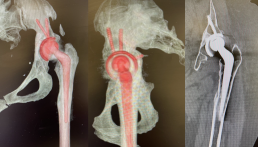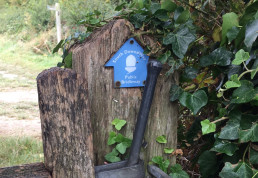Time for a refit. Hip revision surgery and DDH
It’s 22 years since I had a total hip replacement, needed because I was born with hip dysplasia (DDH). Hip replacements of that time last about 15 years, so I feel lucky that I’ve had over 20 from mine. But over recent years, walking without sticks has become more difficult, and in December I learned it’s time for the hip revision surgery.
What is hip dysplasia?
Dysplasia means abnormality. In short, my hips didn’t form properly. When I was born, the socket was too shallow on one side, which means it doesn’t rotate properly. But on the other side, the socket and part of the pelvis were just missing. I spent my early years in and out of Sheffield Children’s Hospital, with open and closed reduction surgeries and in a hip spica between them. You can read more about that in some of my previous blog posts – from my early memories of surgery, to my leg lengthening, my hip replacement and a stabilising knee replacement in 2022. Like many people born with DDH, surgery is just part of my life.
Why does a hip replacement need revision?
Quite simply, the parts, and the fixings, start to wear. Just like a real hip. We humans take a lot of weight through our pelvis and hips, and they are made to move. Don’t know about you, but it’s quite for me to actually stand still. Should have been a jack-in-a-box!
The polyurethane lining in the socket starts to wear, just like with cartilage, and the tiny bits of plastic get into the bone tissue around the hip joint. This causes something called Lysis – which means the bone stops forming so well, and softens around the fixings. And so the socket starts to get looser and some of the parts need replacing.
I mean really, it’s a bit like a shelf. Nice and secure when you first put it up, 20 years later it’s come a bit loose and so needs taking down, some filler and new rawl plugs (if you’re lucky) or if not so lucky, you have to drill in slightly different places and plug the old holes. If anyone medical reads this I apologise for the massive oversimplification of your immense skill.
But it’s kinda what my hip revision surgery is going to be. So, the shaft into my femur is still secure, so my surgery will focus on replacing the ball, the socket and the polyurethane liner. And using bone filler to secure it in place and plug any holes.
A ‘3D printed’ bionic hip
Tech can be frustrating (someone changes the button you knew on Microsoft Teams LOL!). But it’s also amazing what it’s enabled in the medical field. So my new hip has essentially been ‘custom printed’ to fit my strange little pelvis perfectly. How amazing (again, if a little simplified). And how lucky to live in a country where I get to have that surgery.
Four days to go
So I’m now on the final prep journey, with 4 days to go until my hip revision surgery. I’ve had my pre op assessments, had the handover at work and I've been swimming as much as I can, and sorting out my home for what I’m told will be a “no picnic” kind of rehab. More on what’s involved in that, and some unusual places to get what I need, in my next post.
Until then, I’m hoping for as much sunshine as possible whilst I can still get out and about. Hope the weather is kind to you all too, wherever you are reading.
Until next time….
Jill Pringle was born with bilateral hip dysplasia in 1971. After an early childhood in a hip spica and various surgeries, she now writes about her experiences of living with her DDH, her surgeries and her walking challenges to raise money for Steps.
Adult DDH: walking and talking with different abilities
Last weekend I walked another 14.5miles, and on the first day I was joined by two friends. I was born with hip-dysplasia and it was obvious immediately that my hips weren’t normal. I knew nothing of Adult DDH until I found Steps Charity last year. It turns out that many people are diagnosed in their 20s and 30s rather than as children, as hip checks for babies don’t always catch DDH – as was reported recently by the BBC.
On day one of this walk I set off from Pyecombe and walked the
three miles uphill to Ditchling Beacon – one of the most popular parts of the South
Downs Way. There I met Sam Beale – who had
contacted me after reading my blog last year.
Sam supports Steps Charity and was diagnosed with DDH in her early 30s –
almost three years after experiencing hip-pain mid-way through pregnancy. You can read more about Sam’s
story here and what strikes me most is how long it took to get a diagnosis
of Adult DDH. As Sam said to me, a
common problem is that doctors think you’re “too young for joint problems” so don’t
think to look for so many conditions and especially hip-dysplasia. After 3 years
Sam had a PAO; surgery which breaks and re-aligns the pelvis in three places and
takes considerable time and pain to recover from.
Sam and I walked along the ridge of the Downs from Ditchling
Beacon towards Black Cap with her joyous dog Amber darting to every passer-by to
say hello. It was a clear and sunny day
with spectacular views to surrounding villages and even out to sea. It was so amazing to meet someone whose story
of diagnosis is so different, and yet we have so many shared challenges. Like walking downhill (if you have DDH it’s
unlikely that “it’s all downhill from here” is motivating). Or squatting exercises in the gym (hip
dysplasia comes with flat as a pancake buttocks). Or simply trying to judge how far you can
walk without being in pain the following day.
For the second half of my walk I was joined by my good
friend Hayley Manning. Hayley and I sing
together, and she also writes a blog about
grief and loss. She is currently training
for a three peaks challenge to raise money for Child Bereavement UK. What I
love about Hayley is her ability to really connect with people and it was
lovely to share part of my walk as she trained for hers. We sat at the ridge of
Black Cap eating sandwiches and putting the world to rights (obvs) before
making our way downhill to enjoy a cuppa at Housedean Farm where I was staying
overnight.
One of the things we talked about was the reaction adults
vs. children have to people who are different.
I recently heard a brilliant programme on BBC
Radio 4 about awkwardness – and how managing other’s reactions and awkwardness
is one of the hardest challenges differently-abled people face because as
adults we’re trained not to ask the obvious questions that a child would. Kids
aren’t awkward – they see something different, they ask why, and they accept
the answer.
I felt very blessed to have had two such wonderful people to
share my walk, and I’ll be posting a social walk shortly to invite others to
come and walk with me as I reach the end of my challenge.
Day two I walked alone. Although it was predicted to pour
with rain all day actually I just got intermittent drizzle. Heading uphill from the A27 I was soon on the top
of the ridge. OK, so when I say soon, I
mean it took me over an hour. I was
passed (four times) by a couple who were training for the Beachy Head Marathon
by running up and down the hill, and it was lovely to chat to them about what
we were each training for. Different-abilities,
different challenges yet each of us were pushing ourselves to the max in the
same great landscape. I then had a
thrilling walk along the ridge – views of pretty churches towards Lewes one way
and chalk cliffs and the sea the other.
I ended my walk in Southease – a chocolate-box hamlet with thatched
cottages around a village green. I was
in some pain and it’s taken me 2-3 days to stop hobbling, but I felt good.
I believe that we are all differently-abled and we
can all challenge ourselves to grow. I never
thought I would walk this far, yet here I am – over 80 miles of my challenge done
and just 3 days walking left.
I’ll be doing that in mid-late October and I’ll post the dates and times. I’m hoping to invite others with hip-dysplasia – young or old – to join me for a couple of miles in the valley around Alfriston where the path is much easier. Then I will head over the Seven Sisters to Eastbourne. I hope to see people of all abilities there and if you’re interested message me or comment here and I’ll let you know where and when.
Until then, much love to everyone out there who has helped me get this far. I couldn't have done it without your support xx
Jill Pringle is walking to
raise awareness of hip dysplasia (childhood and adult DDH) and raising money
for Steps Charity. If you would like to donate please do so
here - £5 would provide a full information pack to the family of someone newly
diagnosed.


